At 12:12 a.m. on July 27, 2022, the ZK-1A launch vehicle developed by the Institute of Mechanics, Chinese Academy of Sciences launched from the Jiuquan Satellite Launch Centre, putting six satellites in the planned orbit. The six satellites were aligned in the configuration of "six stars in one arrow", and the launch was a success. The ZK-1A launch vehicle's inaugural mission accomplished a complete success by deploying six satellites into the pre-established orbit all at once. This "one-rocket-six-stars" approach enhances China's solid launch vehicle capacity and confirms its status as the preferred pick for small-to-medium-sized satellite launches.
Supported by the Chinese Academy of Sciences (CAS) under their "14th Five-Year Plan", the "Power Arrow 1" rocket is another inventive venture by CAS in the space science and technology field. Focusing on the needs of space science and technology, with engineering as the guiding principle and a focus on innovation, efficiency, and advancement in design, developing launch vehicles that are innovative, advanced, and cost-effective is vital to drive change and innovation in China's launch technology and development methods and promote progress in space science.
The "Power Arrow I" is China's biggest solid launch vehicle, designed by the Institute of Mechanics at the Chinese Academy of Sciences, with China Aerospace Corporation's involvement. It has progressed to the forefront of the world's solid launch vehicles due to its capacity, precise orbiting, dependable design, and cost-effectiveness. The rocket is a solid launch vehicle with four stages. It weighs 135 tonnes and has a take-off thrust of 200 tonnes. The total length of the rocket is 30 metres, with a core stage diameter of 2.65 metres and the first flight state fairing diameter of 2.65 metres. It is capable of carrying up to 1500 kg in a 500 km sun-synchronous orbit.
It has been reported that the "Force Arrow One" rocket development is being carried out by various institutions including the Chinese Academy of Sciences, Aerospace Science and Technology Group Corporation, four hospitals, and other units. Their mission is to conduct scientific research tasks while adhering to the design concept of "innovation, innovation, re-innovation". This led to breakthroughs in designing large solid tonnage rockets. The team has achieved breakthroughs in several crucial technologies, including the best design and testing technology for large solid vehicles, advanced power systems and thrust vector control technology, modern centralized-distributed space electronics technology, low-cost rocket structure and separation technology, intelligent flight control technology, and the use of large solid rockets for ground and hot launches. The company has developed efficient, low-cost, and nimble processes through innovative research methods. They have also made significant contributions to the technological advancements in the field of China's launch vehicles.
The "Power Arrow 1" rocket has many benefits, including its capacity, accuracy, reliability, speed, efficiency, simplicity, affordability, versatility, and environmental adaptability. As such, it's ideal for launching groups of medium or small satellites into medium or low orbits at a reasonable cost and without extensive safety measures.
The mission is carrying six satellites, specifically the Space New Technology Test Satellite (SNTTS), the Orbital Atmospheric Density Detection Test Satellite (OADDS), the Low Orbit Quantum Key Distribution Test Satellite (LOTQDTS), the Electromagnetic Assembly Test Dual Star (EMADS), and the NanYue Science Star (NYSST) which were developed by the Shanghai Aerospace Space Technology Co. The New Space Technology Test Satellite is a platform for testing new space technology that is rapid-response, scalable and general-purpose. The satellite will conduct experiments using novel types of payloads for space science purposes.
